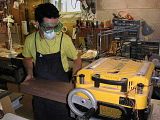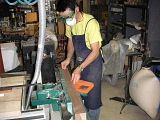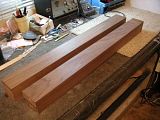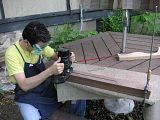To start off with, I put the board through the thickness planer. This maching will take a rough cut board, and put a nicelt planes flat surface on one side of it. If you're careful, you can get two perfectly parallel surfaces.

Secondly, I then cut this large board in to two boards. I ran them though my boss's joiner. A joiner will cut a perfect 90* angle to a prepped peice of wood. The joiner my boss built is made by Grizzly. It is an amazing machine.


Lastly for the night, I routed my truss rod channels. The truss rod is an adjustable rod that controls the bow of the neck. Since I squared up all my edges, I chose to route the channel now, before cutting the necks out. Once cut out, I would have had to figure out some way to hold the neck down while I routed. That could be dangerous. The top, and bottom of the board get routed, because I am able to cut two necks out of each board.

3 comments:
Question: how do you manage to rout a straight channel?
my router has a guide that runs along the side of the board. I used a test piece to make sure it is set correctly, because it's a bit tricky to get right.
You could also use a fence on a table router.
Ok...
Well you can only do that if you've got a square cut board. In my case, my telecaster neck has been roughly cut out of the board (I received it like that. I'll have to find another way to get it done.
Post a Comment